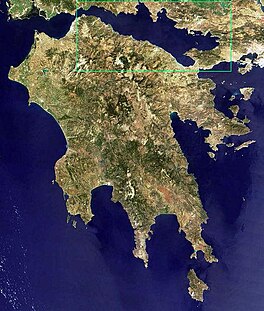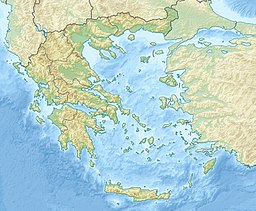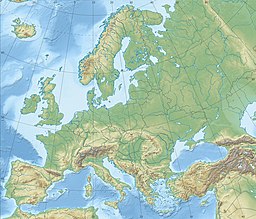| Gulf of Corinth | |
|---|---|
| Κορινθιακός Κόλπος (Greek) | |
 Gulf of Corinth | |
| Coordinates | 38°12′N 22°30′E / 38.200°N 22.500°E |
| Type | gulf |
| Part of | Ionian Sea (Mediterranean) |
| Basin countries | Greece |
| Max. length | 130 km (81 mi)[1][full citation needed] |
| Max. width | 32 km (20 mi) |
| Min. width | 8.4 km (5.2 mi) |
| Surface area | 2,400 km2 (930 sq mi) |
| Max. depth | 935 m (3,068 ft) |
The Gulf of Corinth or the Corinthian Gulf (Greek: Κορινθιακός Κόλπος, romanized: Korinthiakós Kólpos, Greek pronunciation: [koɾinθiaˈkos ˈkolpos]) is a deep inlet of the Ionian Sea, separating the Peloponnese from western mainland Greece. It is bounded in the east by the Isthmus of Corinth which includes the shipping-designed Corinth Canal and in the west by the Rion Strait which widens into the shorter Gulf of Patras (part of the Ionian Sea) and of which the narrowest point is crossed since 2004 by the Rio–Antirrio bridge. The gulf is bordered by the large administrative divisions (regional units): Aetolia-Acarnania and Phocis in the north, Boeotia in the northeast, Attica in the east, Corinthia in the southeast and south and Achaea in the southwest. The tectonic movement across the gulf is comparable to parts of Iceland and Turkey, growing by 10 mm (0.39 in) per year.
In the Middle Ages, the gulf was known as the Gulf of Lepanto (the Italian form of Naupactus).
Shipping routes between the Greek commercial port Piraeus (further away from ultimate destinations but larger and better connected to the south than the north-western Greek port of Igoumenitsa) to western Mediterranean and hemisphere ports pass along this gulf. A ferry crosses the gulf to link Aigio and Agios Nikolaos, towards the western part of the gulf.[2]
- ^ Thalassographica, Institute of Oceanographic and Fisheries Research, vol. 11–15, p. 35, (1988)[title missing][author missing]
- ^ "Greece's first electric ferry announced". Plugboats. 19 December 2019.


